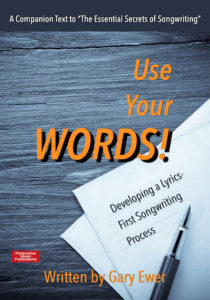Good songs are almost always about contrasts. If you look closely at chord progressions, you’ll notice major and minor chords: opposites working together. With instrumentation, you’ll often see sparse, transparent sections (often the verse) contrasting with fuller, busier parts (the chorus).
Contrast is an important part of what keeps listeners coming back to your song. Experiencing contrast is an instinctive part of the enjoyment of music. Sometimes you’d think there are no contrasts at all within a song, where everything sounds more or less repetitive.
 The best songwriters are best because of the power of the words they use. Read “Use Your Words! Developing a Lyrics-First Songwriting Process” in order to become a better lyricist. Right now it’s a FREE add-on to “The Essential Secrets of Songwriting 10-eBook Bundle.”
The best songwriters are best because of the power of the words they use. Read “Use Your Words! Developing a Lyrics-First Songwriting Process” in order to become a better lyricist. Right now it’s a FREE add-on to “The Essential Secrets of Songwriting 10-eBook Bundle.”
In songs where there seems to be little contrast — like Stevie Wonder’s “Superstition”, for example — it’s just that the notion of contrast becomes much more subtle. In that song’s case, you subconsciously become aware of the fact that the verses all focus strongly on the tonic chord, the underlying harmony that supports that iconic instrumental hook. That makes the switch to the dominant chord at the chorus much more powerful, and much more important.
How about melodies? The various melodies that a song uses seem a bit random with regard to its upward and downward direction. Is there any kind of system in play within a song that makes melodic contrast a vital part of its construction?
The answer is yes, and you need look no further than the basic concept of how much a melody moves up and down. In other words, there is a musical logic to the range of your melodies.
When we talk about range, we mean comparing the lowest notes within that melody to its highest notes. But when it comes to how important a melody’s range is, it’s more relevant to look at:
- how high the melody goes within each song’s section;
- how much time a melody spends sitting in and around its highest notes.
The reason that melodic range is such an important part of songwriting is that we pick up greater energy in the music the higher the voice moves.
In “Superstition”, ignoring some vocal improvisations, both the verse and the chorus hit high Gb (Key of Eb dorian). So you could say that there really isn’t any contrast in the melodic range of verse and chorus in this song.
While that’s true, you’ll notice that the chorus “sits higher” than the verse. The verse keeps hitting that high Gb, but then quickly moves down an octave lower. But in the chorus, that Gb happens, and the move downward doesn’t happen. So it gives the impression of Gb being a more important note, and we pick up a stronger sense of musical energy by the more constant high placement in the chorus.
In that sense, it’s comparing the lower notes of the verse and chorus melodies that shows us the greater contrast. The low notes of the chorus are higher than the low notes of the verse.
How melodies move up and down within your song is a relative thing. For some songs, the chorus may sit a full octave higher than the verse (“Free Fallin'” – Tom Petty), or it may be practically the same, as in “Superstition”.
But no matter what the situation for your song, as long as the difference is there, it can be a very subtle thing. If you find that your songs are missing the kind of chorus “pop” that you wish it had, take a look at your song’s melodies, and compare their ranges. You should see some contrast there.
 Written by Gary Ewer. Follow Gary on Twitter.
Written by Gary Ewer. Follow Gary on Twitter.
 “The Essential Secrets of Songwriting” eBook bundle includes the all-important Study Guide. Discover the secrets of making the chords-first songwriting process work for you.
“The Essential Secrets of Songwriting” eBook bundle includes the all-important Study Guide. Discover the secrets of making the chords-first songwriting process work for you.










